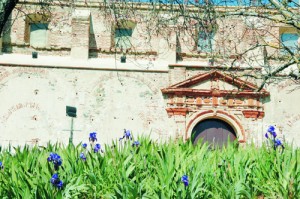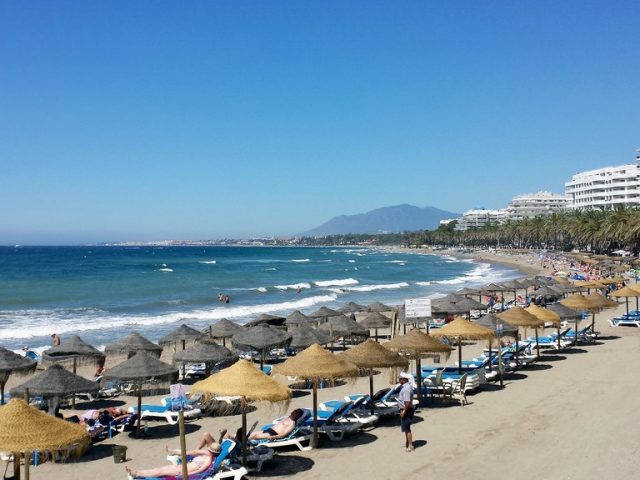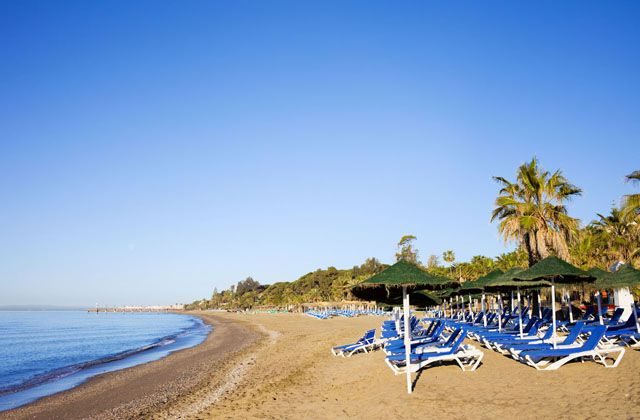- Have any questions?
- +34 951 273 575
- info@allaboutandalucia.com
Ham-azing Aracena!

Travel through Jerez in latest excerpt from expat author Nick Nutter
June 13, 2016Marbella: Growing up gracefully
June 13, 2016
The view from Almonaster la Real mosque
There are no cinemas, beaches and Chinese takeaways, but it’s ham heaven in the rolling mountain region of Aracena that few have heard of and even less visit, discovers Jon Clarke
FROM my perch high above Almonaster la Real, I sit contemplating the spectacular vista from what must once have been the Moors’ most scenic mosque.
Swallows swoop around the historic monument as I gaze into the far distance across a rolling sea of oaks, chesnuts and pines.
Almost on cue, a lone piper starts belting out a medieval standard from somewhere below.
It is almost enough to consider converting… but then that would mean missing out on easily the best delicacy Spain has to offer.
For in the cork woodlands in front of me graze what must be the happiest pigs on earth.
Going on to produce the best ham in the world, the famous black Iberian pigs live free-range for up to four years, grazing on a diet of almost entirely acorns.
First noted by Laurie Lee in his classic tome As I Walked Out One Midsummer Morning, you can clearly taste the sweetness of the jamon Iberico the minute you enter these verdant hills.
A breathtakingly beautiful area of woodland, scenic walks and authentic, unspoilt whitewashed villages, yet almost nobody has heard of the Sierra de Aracena.
“And that is even on the coast in our own province of Huelva,” explains local hotelier Lucy Arkwright, from Posada San Marcos.
Close to the Portuguese border, an hour north of Sevilla, the Sierra de Aracena – Andalucia’s second-largest natural park – is sandwiched between the wild plains of Extremadura and the heat of the Andalucian heartland.
It is about as different to the Costa del Sol as Fortnam & Mason is to Iceland.
But that’s not to say that the English haven’t discovered it yet. On the contrary, it is close to here – at Minas de Riotinto – that in the 19th century, British miners and engineers laid out Spain’s first golf course and football pitch.
The nearby hills – a romantic, almost melancholy sweep of wilderness – was their playground.
“But it has also long been an exclusive escape for rich Sevillanans,” explains Aracena mayor Manuel Guerra.
“The grandparents of the king used to holiday here and the aristocracy built grand houses.
“They came to enjoy the wonderful countryside and nature,” he adds.
It is certainly the perfect antidote to the hideous development that has scarred much of the Costa del Sol.
And while Aracena has never courted the hordes of Brits who flock to Spain, to be fair, it’s probably not their cup of tea either.
Indeed, as the expatriate locals are quick to point out, the rainfall figures are the second highest in Spain and apart from walks and nature, there is not a lot else to do.
They have got a point. There are no beaches, casinos or Chinese takeaways in Aracena and the locals mostly don’t speak English.
That said, according to one local estate agent Alfonso Pardo increasing numbers of Britons are flocking there to find a home with Julie Christie, Bryan Ferry and Roland Olazabel from Tears for Fears all casting an eye over its housing stock in recent years.
“The word is out that this is one of Andalucia’s last unspoilt zones,” says Pardo, a former actor, who moved here over a decade ago. “But it is already expensive due to the exclusivity of being in a natural park, which puts tough restrictions on building.
“As well as that there is a lot of competition from wealthy Spaniards, who have the romantic notion of owning a retreat here. All this gives the area a certain cachet, which no-one wants to spoil, and ultimately nobody shouts about it from the rooftops.”
The reasons for its popularity among those-in-the-know becomes quickly obvious as you drive up from the dusty dry plain of Sevilla, its sun-baked expanses slowly giving way to a rich, muddy green spread of oak and chestnut woodland.
But while its crystal-clean air and natural setting has so much allure, it is the timeless, picturesque villages and their sylvan hinterlands that make the region so special.
Alive with the chatter of children and served by a surprisingly good network of shops and restaurants, somehow the two dozen or so settlements manage to maintain their pastoral identities and continue thriving without modern development.
It is this anomaly unlike so many other parts of Spain that so appealed to Nick Winer, when he and his wife settled in the area five years ago.
Having travelled the world, and in particular Africa, where he worked in famine relief with Oxfam, he needed somewhere quiet to lay down his hat.
“It has always been a friendly place, where the locals are happier than most and not every young person flees the minute the chance comes up,” says Winer, who had first fallen in love with Spain while living temporarily in a cave house in Almeria in the 1970s.
The reason behind this, he explains, is that Aracena is one of the few areas of Spain where the latifundio, or big landowner system, never took root.
Apparently too difficult to support large estates, instead the locals shared out the smallholdings that surrounded their villages.
Similar to that in the Alpujarras, near Granada, most would have a small olive grove, a few chestnut trees and an orchard for fruit. And as there was never a water shortage (there is over 1000mm of rainfall a year) they always had food and used to make money sending their produce by bullock cart to Sevilla every week.
As Winer, a project manager, explains: ‘In Spain land has always been everything and as a result the area never got divided between the haves and have-nots. With land they could access loans and improve their lot.
“You can really feel that today in the villages, where the rural economy is strong enough to support its young people and the villages aren’t full of old ladies dressed in black.’
Another couple magnetically drawn to the area are Sam and Jeannie Chesterton. Without a doubt, the British pioneers to Aracena, they bought an estate in the area in 1982.
Having moved to Spain so Sam could concentrate on his writing they soon decided to open a B&B to make ends meet.
The decision had been made soon after meeting his wife Jeannie at a party in London.
“I put two propositions to her in one breath. I asked her to marry me and move over to Spain at the same time,” recalls charmer Sam. “Luckily she also loved the mountains and was up for the idea of catering.”
While they pined for a classic cortijo to renovate, it was a far from easy task as most of the places they visited came with 500 hectares and cost too much.
Then one day they stumbled across finca Buen Vino. The huge estate was covered in primroses and heather and had wonderful views.
“By the next morning we were hooked,” recalls Sam.
Taking a look around from their terrace it is not hard to see why.







